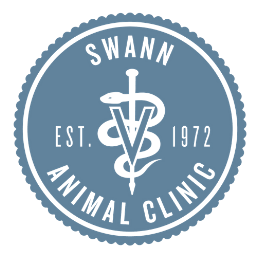As a veterinarian, there are cases I see on a daily basis that are hard on me. Some of them are the old dog that families have to say goodbye to. Some are the tragic cases that no one sees coming, like car accidents. But the ones that seem to be harder and harder for me to see are what I call the “parvo puppies.” We have been seeing an increasingly large number of parvo puppies, so this is what I’m writing about this month.
Parvo Virus Enteritis is caused by Canine Parvovirus. This virus is incredibly stable in the environment and can last up to a full year in the right areas. The virus affects mainly young, unvaccinated puppies (although any aged dog can get it). These puppies get sick from oronasal (mouth and nose) contact with the virus. The virus attacks rapidly replicating cells in the body such as the lymph nodes, heart muscles, and the epithelium or lining of the intestines. This is why we see the clinical symptoms that we see. Let’s talk about those!
The most common signs we see are lethargy, vomiting, and bloody diarrhea. This is caused by the virus attacking the lining of the intestines. Eventually, the intestinal lining will die and slough (this is what causes the bloody appearance). The problem with this (besides the obvious pain and intestinal signs this causes) is that the lining is no longer there to keep bacteria in the intestinal lumen. The bacteria are then able to cross over into the bloodstream causing the puppy to become septic. This problem is then propitiated by the fact that the virus attacks the lymph nodes. This means that they typically do not have a good supply of white blood cells to fight the bacteria in the bloodstreams. All of this leads to the other clinical symptoms we can see of severe dehydration, fever, abdominal pain, pale gums, and weak pulses. If a puppy is infected in utero, their heart cells can be infected causing myocarditis that can lead to heart failure. These guys are sick!!
When any puppy (vaccinated or not) comes into a veterinary clinic with lethargy, vomiting, or diarrhea, they will likely tell you that they would like to run a test for parvovirus. The most common test involves swabbing the tonsils and the colon. This is then run through a test that is looking for antibodies (the body’s fighting cells) to the virus. False negatives can occur if you test too early in the disease because the body has not had a chance to make these cells. If your puppy comes up positive, we will likely want to run blood work. This will tell us the big picture of where their white blood cell count is, if they are hypoglycemic (low blood sugar), or if they have any electrolyte abnormalities that will need correcting. Once we have all of this information, we will talk to you about the treatment.
Gold standard treatment for parvovirus is hospitalization. When your puppy is in the hospital, we will put them on IV fluids to keep them hydrated and keep their blood pressure up. If they need sugar or electrolytes, we can add this to their fluids. We will also put them on IV anti-emetics (anti-vomiting) medications and IV antibiotics. If your baby is painful, we will also add IV pain medications too. You will notice that all of these treatments are supportive. There is no medication that directly attacks the virus. We simply have to support these little ones until their body passes the virus. This usually takes an average of 3-5 days in the hospital. You can guess that this is costly. I know that, but it is what they need. If you are not able to hospitalize your puppy, your veterinarian will talk to you about take-home treatment. This will involve, subcutaneous fluids (underneath the skin), oral medications, and forcing food and water. This takes a lot of work and around the clock care. The survival rate for hospitalization is 90%. The survival rate for at-home care is 50%.
I said at the beginning of this blog that these cases are hard on me, and it’s the truth. These puppies are so so sick when they come in and they feel miserable. But the reason that these cases are hard on me is that this disease is completely and 100% preventable. Parvovirus is one of the viruses that we vaccinate for during those very important puppy vaccination series. If you have all of the vaccinations done by a veterinarian at the appropriate timing, your pet will be safe from the virus. It’s that easy. It cost an average of $30 per vaccination. So total, you are looking at about $120 for the 3-4 vaccinations of the puppy shots. You can pay thousands of dollars to treat in the hospital. Please, please, please vaccinate your puppy! We do not ask you this to make money (as you can see, we would make more money if you didn’t listen to us). We advise this because we love our patients.
As always, if you have any questions, contact your veterinarian. They are always the BEST place for advice and information about your pet.
About the Author
Dr. Heritage Enevoldsen
 Dr. Heritage Enevoldsen was born and raised in Amarillo, Texas. She had always dreamed of finding a job that would allow her to minister to and bless people, but also involve her love for animals, so being a veterinarian was just the right fit! She received her Bachelor of Science from Texas A&M University before graduating from Texas A&M College of Veterinary Medicine in May of 2017. Her goal was always to come back and serve the people of the Texas panhandle. Dr. Enevoldsen has a special interest in dermatology, surgery, and dentistry as well as client education. When she isn’t working at the clinic, Dr. Enevoldsen loves spending time with her son and husband, reading, and anything to do with the Fighting Texas Aggies. She is a dog mom to her pet, Mark, who is the most handsome mutt you have ever seen.
Dr. Heritage Enevoldsen was born and raised in Amarillo, Texas. She had always dreamed of finding a job that would allow her to minister to and bless people, but also involve her love for animals, so being a veterinarian was just the right fit! She received her Bachelor of Science from Texas A&M University before graduating from Texas A&M College of Veterinary Medicine in May of 2017. Her goal was always to come back and serve the people of the Texas panhandle. Dr. Enevoldsen has a special interest in dermatology, surgery, and dentistry as well as client education. When she isn’t working at the clinic, Dr. Enevoldsen loves spending time with her son and husband, reading, and anything to do with the Fighting Texas Aggies. She is a dog mom to her pet, Mark, who is the most handsome mutt you have ever seen.
